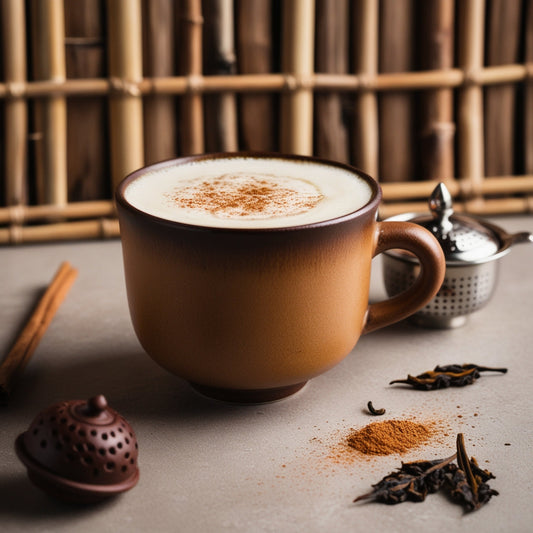Overview
Green tea, a cherished beverage across the globe. It boasts a distinctive flavor profile and numerous health benefits of green tea . Why is it called green tea, and why isn't it always green? What causes its bitterness, and how can you brew it to perfection? We dive into these intriguing questions, uncovering the secrets behind green tea's vibrant appearance, unique taste, and optimal brewing methods. Whether you're a seasoned tea enthusiast or just beginning your journey, you'll gain valuable insights that will enhance your appreciation and enjoyment of this ancient drink. Let`s explore the fascinating world of green tea!
Table of Content
- Introduction
- Why Green Tea is Called Green Tea?
- Why Is Green Tea Not Green?
- Why Green Tea Taste Bitter?
- The Processing Methods of Green Tea
- How to Brew Green Tea for Best Flavor
- Conclusion
Introduction
Green tea is a popular beverage known for its numerous health benefits and distinctive flavor. People around the world enjoy its refreshing taste and soothing qualities. This versatile tea offers a unique combination of characteristics, from its vibrant green appearance to its subtle yet sometimes bitter taste. Understanding the reasons behind these qualities, along with the best brewing techniques, can enhance your appreciation and enjoyment of green tea. We will explore why green tea is not always green, what causes its bitterness, and how to brew it perfectly to maximize its flavor and health benefits.
Why Green Tea is Called Green Tea?
Green tea comes in many variations, but two main points define it clearly. First, green tea leaves are green, which is why it's called green tea. All tea comes from the same plant Camellia sinensis, and like most plants, its leaves are green. Second, green tea production stops oxidation because the leaves are “dried” shortly after being picked. This high-heat process breaks down the enzymes that cause oxidation, this process that turns green tea leaves into black.

Why is Green Tea not green?
Green tea isn't green due to its processing method. Producers quickly heat fresh tea leaves, either by steaming or pan-firing, to inactivate the enzyme polyphenol oxidase. This step prevents the oxidation of the tea leaves natural polyphenol compounds, which would otherwise turn the leaves brown. By preserving the green color of the fresh leaves, green tea maintains its vibrant green appearance. The heating process also helps to retain the tea's delicate flavor and aroma.
Why does Green Tea Taste bitter?
Green tea tastes bitter because of certain compounds in the tea leaves. The main compounds responsible for this bitterness are catechins, specifically epigallocatechin gallate (EGCG). Catechins are natural polyphenols in green tea that have a distinctive bitter and astringent taste. Factors such as growing conditions, harvesting time, and processing methods influence the bitterness in green tea. Teas harvested earlier in the spring tend to have higher concentrations of catechins, leading to a more bitter flavor. Additionally, the processing methods, such as the degree of oxidation, affect the final bitterness of the tea. Brewing techniques, like using excessively hot water or steeping the tea for too long, can also increase bitterness. Proper brewing, using water around 80–85 °C and steeping for 2-3 minutes, helps minimize bitterness and enhances the delicate, grassy, and sweet notes in green tea.

The Processing Method of Green Tea
Green tea comes from the Camellia sinensis plant, and the amount of oxidation allowed during the drying cycle determines the color of the tea. Green tea undergoes a shorter drying period to prevent further oxidation, ensuring the leaves retain their green color. Once the moisture evaporates, the leaves are heated and curled. Heating methods vary by region and technique. Chinese green teas are pan- or wok roasted, resulting in a paler color, while Japanese green teas are deeply steamed, giving them a brighter green color. The final step involves rolling, curling, or twisting the tea leaves by hand to wring out any excess water or sap, defining the different tea types.
How to Brew Green Tea for Best Flavor
To brew green tea for the best flavor and health benefits, use freshly drawn, pure, filtered water heated to between 160°F and 180°F. Avoid boiling the water, as this can make the tea bitter. Use about 1-2 teaspoons of high-quality loose leaf green tea per 8 oz. of water. Steep the tea for 2-3 minutes, avoiding over-steeping, which can also cause bitterness. The shorter steep time helps preserve the delicate antioxidants and nutrients in the green tea. After steeping, remove the tea leaves or tea bag to prevent further extraction. Enjoy the green tea while it is hot for the best flavor and maximum health benefits.
Conclusion
Green tea offers a rich tapestry of flavors and benefits from its unique processing methods and natural compounds. By understanding why green tea isn't always green and what contributes to its sometimes bitter taste, you can better appreciate this ancient beverage. Now that you know how to brew green tea for the best flavor and health benefits, why not try it yourself? Experiment with different brewing techniques and discover your perfect cup. Enjoy the journey to mastering the art of green tea and enjoy without side effects!
To further enhance your tea experience, expand your collection with Pu-erh tea from Puerh Craft. Its distinctive flavor and health benefits can seamlessly complement your pursuit of greater vitality and relaxation, offering a well-rounded addition to your tea repertoire.
Q&A
Q. Why is green tea called green tea?
A. Green tea is called green tea because the leaves maintain their green appearance through the processing method. Unlike black tea, green tea leaves are quickly heated after being picked to prevent oxidation, which preserves their natural green color.
Q. Why isn't green tea always green?
A. Green tea isn't always green due to the specific processing methods used. The fresh tea leaves are either steamed or pan-fired to inactivate the enzyme polyphenol oxidase, preventing oxidation. This process retains the green color of the leaves, although the shade of green can vary depending on the method and region.
Q. Why does green tea taste bitter?
A. Green tea tastes bitter because of the catechins, particularly epigallocatechin gallate (EGCG), present in the tea leaves. These natural polyphenols have a distinct bitter and astringent flavor. Factors like growing conditions, harvest time, and processing methods also influence the bitterness. Improper brewing, such as using water that's too hot or steeping the tea too long, can enhance this bitterness.
Q. What are the main processing methods for green tea?
A. The main processing methods for green tea include steaming and pan-firing. Steaming, commonly used in Japanese green teas, results in a brighter green color, while pan-firing, used in Chinese green teas, results in a paler green color. Both methods aim to prevent oxidation, preserving the green color and delicate flavor of the tea leaves.
Q. How can I brew green tea to get the best flavor?
A. To brew green tea for the best flavor, use freshly drawn, pure, filtered water heated to between 160°F and 180°F. Use 1-2 teaspoons of high-quality loose leaf green tea per 8 oz. of water. Steep the tea for 2-3 minutes, avoiding over-steeping to prevent bitterness. After steeping, remove the tea leaves or tea bag and enjoy your green tea while it is hot for the best flavor and maximum health benefits.






